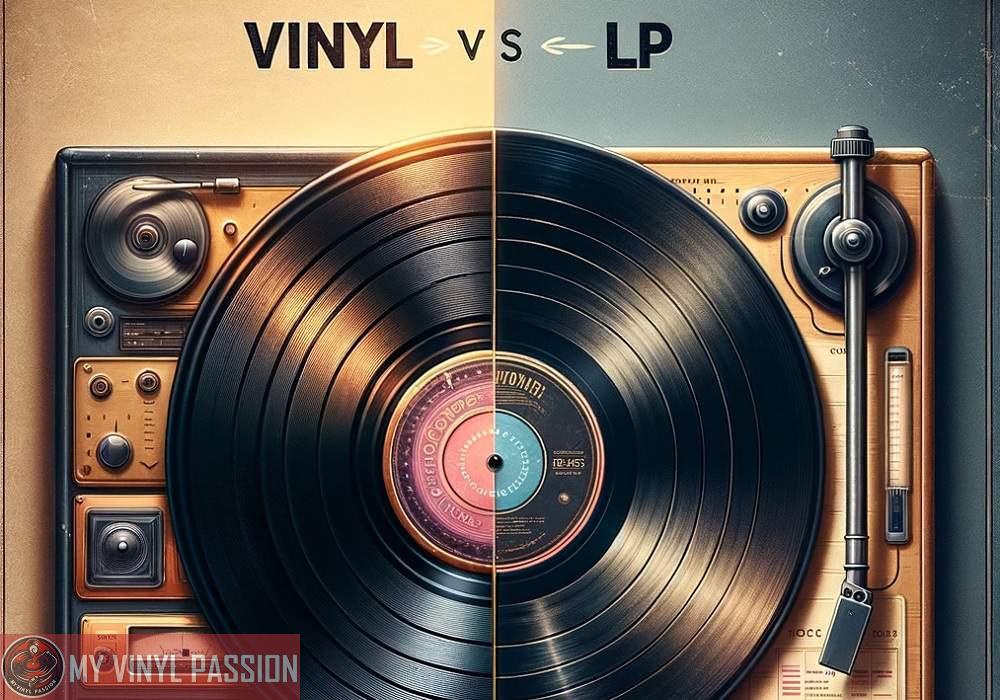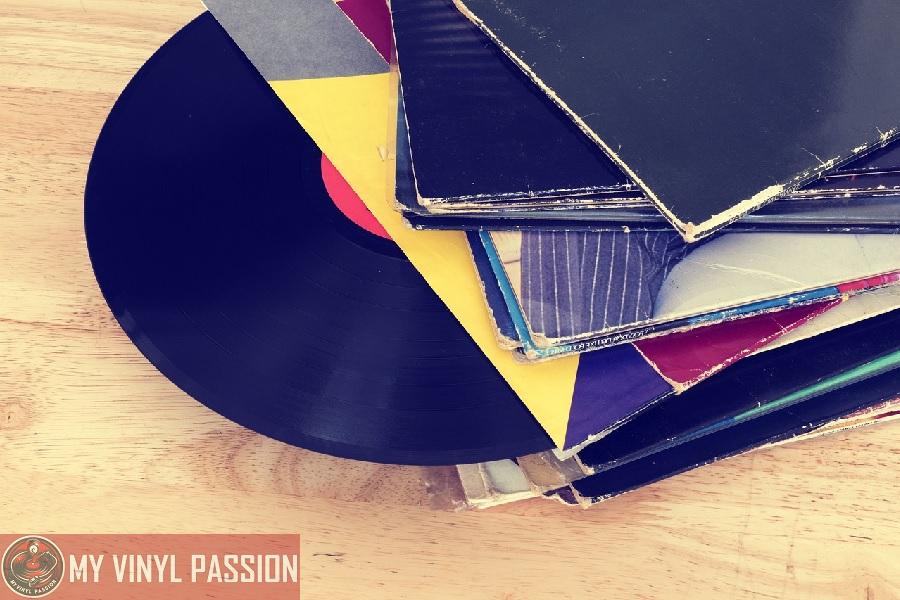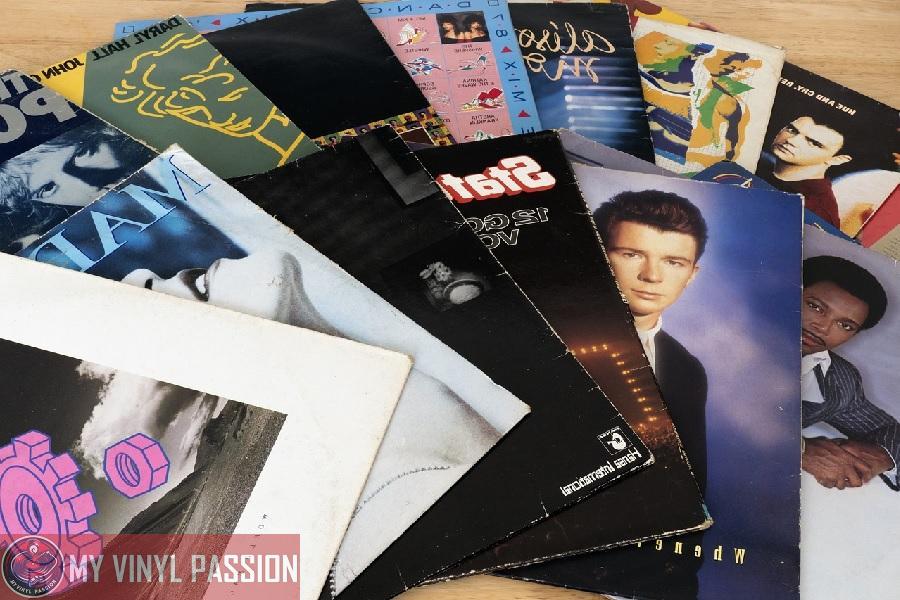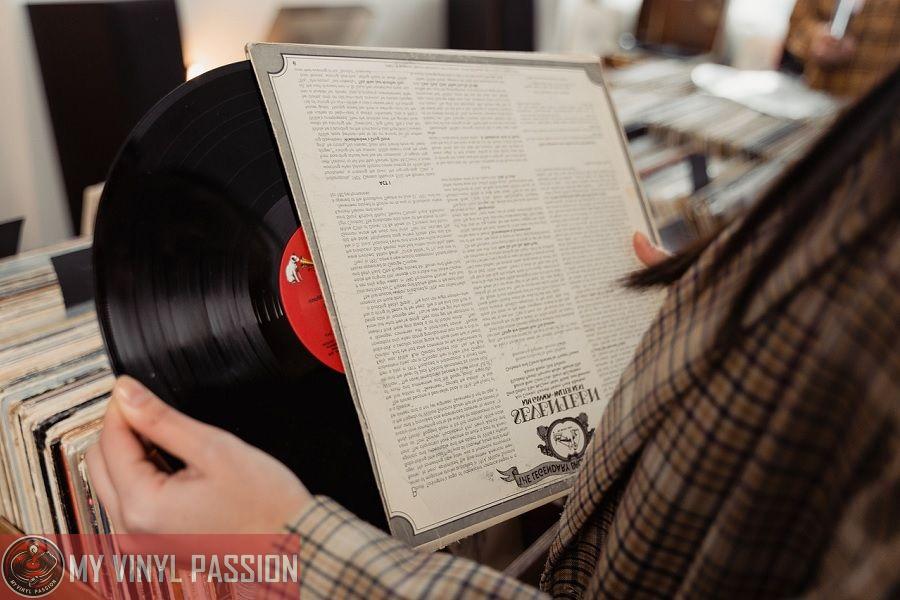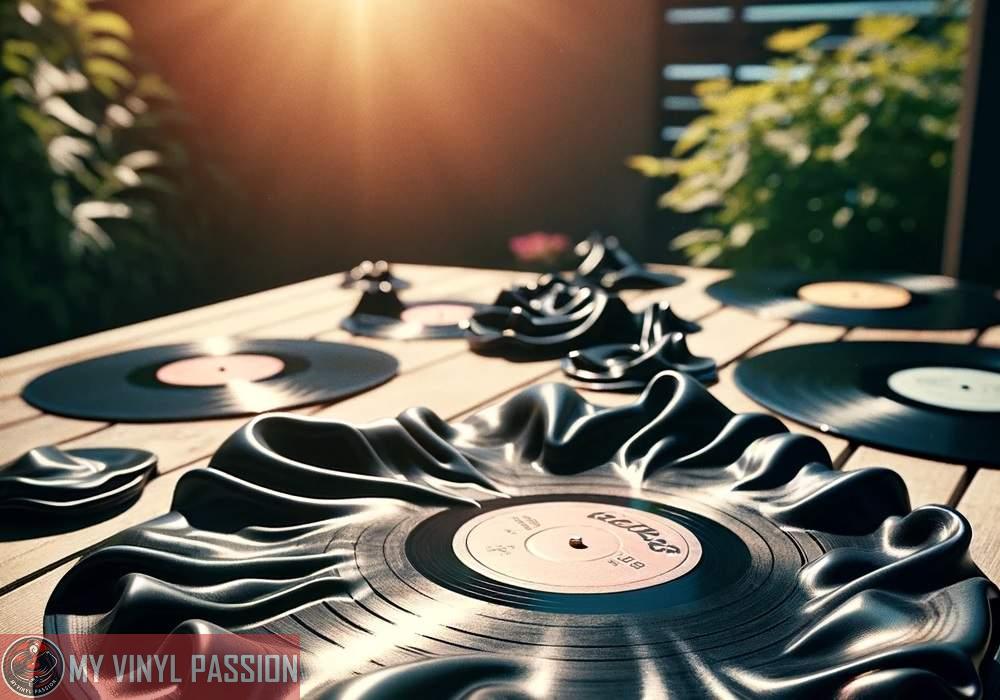In the world of music collection and playback, understanding the nuances between terms like vinyl and LP is crucial for any enthusiast.
Vinyl is a medium that encompasses a variety of record formats based on the material used for pressing records, which in this case is polyvinyl chloride.
This term is often used synonymously with records in general, regardless of the size or the amount of music they contain. Vinyl has seen a resurgence in popularity, reaffirming its place in the music lover’s lexicon.
LP, on the other hand, stands for Long Play and specifically refers to a type of vinyl record.
In Summary
Definition Differences: “Vinyl” refers to the material used to make records, while “LP” (Long Play) specifically denotes a format of vinyl record that typically plays at 33 1/3 RPM and can hold more music than other formats.
Size and Speed: LPs are usually 12 inches in diameter and play at 33 1/3 RPM, whereas vinyl records can come in various sizes (7, 10, 12 inches) and speeds (33 1/3, 45, 78 RPM).
Capacity for Music: LPs generally hold up to 22 minutes of music per side, offering more capacity compared to other vinyl formats like singles (7-inch records) which hold less music.
Usage and Popularity: LPs are popular for full albums due to their longer playtime, while other vinyl formats are often used for singles or EPs.
An LP usually spins at 33 1/3 revolutions per minute, distinguishing it from other formats like singles, which rotate at 45 rpm. LPs were introduced in the late 1940s and provided a longer playing time which made them an ideal choice for albums.
Your favorite albums from the golden age of rock to contemporary releases are likely pressed on LPs.
While all LPs are vinyl records, not all vinyl records are LPs. There are different sizes such as the 7-inch single or the 12-inch single, which have less playing time and typically contain one or a few songs.
When you hold a vinyl LP, you’re holding a piece of musical history, envisioned to deliver a full album experience with rich sound quality that many argue surpasses digital formats. Collecting these can be more than a listening venture; it’s often a journey into the art and soul of the music itself.
Understanding Vinyl and LP Terminology
Before delving into the specifics, it’s essential to discern the distinction between “vinyl” and “LP,” terms often used interchangeably in the context of records. Understanding this terminology will clarify the types and attributes of records available to you.
Linguistic Roots and Jargon
Vinyl is a material—a synthetic plastic polymer known for its durability and flexibility. In the realm of music, vinyl is the substance used to craft records, which serve as a medium for analog sound storage. Over time, the word “vinyl” has become a catch-all term to describe records made from this material.
Record, in the auditory context, refers to an object inscribed with music or sound, intended for playback by a phonograph. Long Play (LP), alternatively, is a format specification.
Originating from the term “long-playing,” an LP is typically a 12-inch record spinning at 33 1/3 rpm (revolutions per minute), enabling it to hold more music—around 20 to 25 minutes per side.
Other record speeds include 45 rpm and 78 rpm, with the former commonly linked to 7-inch discs known as “singles” or EPs (extended plays), and the latter to the older shellac records, which preceded vinyl.
Vinyl Records versus Long Play (LP) Formats
When discussing vinyl records, you are referring to the physical medium that embodies various music formats. These come in different sizes and speeds, such as the standard 12-inch LP, the smaller 7-inch 45 rpm records, and the archaic 78 rpm records once made of shellac.
The microgroove design introduced in LPs was a key part of the metric revolution in recording technology, allowing for more intricate sound details and longer playing times.
The term LP denotes a specific type of vinyl record that typically adheres to the 33 1/3 rpm speed and can play for an extended duration due to its microgroove format.
Introduced by Columbia Records in 1948, the LP represented a leap from the earlier 78 rpm shellac records, which were limited in playback duration.
Here’s a quick overview:
| Type | Size | Speed | Material | Play Time |
|---|---|---|---|---|
| LP | 12-inch | 33 1/3 rpm | Vinyl | ~22 min per side |
| Single (45) | 7-inch | 45 rpm | Vinyl | ~4-5 min per side |
| Old Standard | 10-inch | 78 rpm | Shellac | ~3-5 min per side |
Understanding these terms will guide you in choosing the right type of vinyl record for your musical experience, whether you prefer the longer play of an LP or the short and sweet play of a 45.
The Technical Specs: Size, Speed, and Material
When you consider the vinyl record versus the LP, you need to examine the specifics: size, rotational speed, and the materials used in their production. These factors are crucial in determining the listening experience and durability of your records.
Dimensions and Speed of Formats
7-inch Records:
- Diameter: 7 inches
- Common Speed: 45 rpm
10-inch Records:
- Diameter: 10 inches
- Speeds: 78 rpm (historical use) or 33⅓ rpm
12-inch Records:
- Diameter: 12 inches
- Common Speed: 33⅓ rpm
The 12-inch record rotating at 33⅓ rpm is a standard for LPs, providing a balance between playback time and sound quality.
The smaller 7-inch singles, which usually play at 45 rpm, focus on fewer tracks with a higher rotational speed, often resulting in better sound fidelity for the shorter duration of music. 10-inch records can vary, historically used for 78 rpm shellac records, but can also carry modern vinyl recordings at 33⅓ rpm.
Material Composition: PVC and Its Alternatives
The materials that make up your records largely determine their longevity and sound quality. Historically, records were made of shellac, a brittle material that was largely replaced by vinyl, specifically polyvinyl chloride (PVC).
- PVC:
- Primary material in records
- Durable
- Flexible
- Offers high fidelity
Records are now nearly synonymous with vinyl, a flexible and more durable material that allows for high-fidelity sound reproduction. While PVC is the most popular, efforts to find PVC alternatives are ongoing to address environmental concerns.
However, for now, PVC remains the industry standard due to its proven performance and durability.
Sound Quality and Collectability
In the realm of vinyl and LPs, the terms sound quality and collectability take center stage. These are the driving forces for enthusiasts dedicating themselves to the pursuit of the perfect listening experience and the quest for rare acquisitions.
The Audiophile Appeal: Sound Quality Considerations
Sound quality in vinyl records is a product of the intricate grooves and the manner in which the stylus—or needle—traces them. The unique sound of vinyl often includes a warmth and natural sound profile that audiophiles cherish.
This sound character, including a wide dynamic range and slight crackling, contributes to a nostalgic listening experience. It’s not merely about the music; it’s the ritual of handling and playing the records that enriches your experience.
- Discs & Grooves: The grooves on vinyl records can capture the full-length album with fine detail, giving you a rich audio quality.
- Playing Time: A double LP may provide you with extended playing time, allowing more space for an album to breathe, often desired in the Western world.
- Stylus & Degradation: Be aware that over time, the friction between the needle and the vinyl can lead to degradation, affecting the audio quality. Regular maintenance is crucial.
Collectors’ Corner: The Value of Rarity and Condition
When it comes to record collecting, two main factors influence the investment value: rarity and condition. Limited pressings, misprints, or releases that were pulled from the market can carry a high value due to their scarcity.
- Rarity: Specialty pressings such as colored vinyl or double LP editions often carry a higher collectability factor.
- Condition: A record’s condition is paramount. A mint condition album is more likely to retain its value and can be a significant investment.
- Unique Sound: Certain pressings are sought after for their unique sound not replicated in reissues or digital formats.
As a collector or an audiophile, understanding these aspects helps you curate your collection, ensuring a high-quality listening experience and potentially valuable holdings.
Vinyl and LPs in the Digital Age
In the realm of music, your experience is shaped by the medium you choose. Whether you’re an aficionado of rich analog sounds or prefer the convenience of digital formats, understanding the distinction between vinyl and LPs and their places in the digital age is essential.
The Analog vs. Digital Debate
When you compare vinyl records to digital formats, you’re engaging in a long-standing debate of audio fidelity versus convenience. Vinyl represents the warmth of analog sound that many argue has a more authentic feel, which can make you feel closer to the original performance.
This is due to the continuous sound wave produced by the turntable needle reading the grooves in the record. Digital formats, such as CDs or MP3 files, use samples to approximate these waves; this process, while more storage-friendly and portable, often leads to a loss in subtle audio detail.
The Resurgence of Vinyl: A Cultural Renaissance
Vinyl records have made a significant comeback, often celebrated for their tangible design and the ritualistic experience they offer. This resurgence is not just about the music—it’s about the entire culture encompassing pop icons, collectors, full-length records, and stunning album art.
In a digital age where singles are often prioritized, the vinyl LP allows you to explore a complete artistic vision, offering an immersive experience that digital formats struggle to match.
The record player itself has also evolved, with modern designs emphasizing both sound quality and the aesthetic pleasure of the listening ritual.
Caring for Your Vinyl and LP Collection
Preserving your vinyl and LP records involves careful handling and protective storage. Adequate maintenance can prevent common damage such as dust accumulation and scratches that can degrade sound quality.
Proper Handling and Storage Insights
When you handle your vinyl records, always hold them by the edges or the label to minimize contact with the grooves where dirt and oils can accumulate.
For storage, keep your records in their sleeves and upright in a sturdy LP storage case. These should ideally have double-hinged flaps for easy access and additional protection. It’s also important to differentiate by speeds; store 33 rpm LPs separate from 45 rpms, as mixing formats can lead to unwanted pressure on the vinyl.
Handling Vinyl:
- Hold by edges or label
- Do not touch grooves
Storing Records:
- Upright position
- Inside protective sleeves
- In LP storage cases
Environment and Maintenance Tips
Your vinyl’s playing and storage environment should be kept clean and stable. Ensure the area is free of dust, which can settle into the grooves and cause a decline in audio fidelity. For maintenance, clean your records regularly with a soft, anti-static brush before and after playing to remove any dust particles.
Additionally, vinyl should be kept away from direct sunlight and stored in a cool, dry place to prevent warping and other heat-related damage. Using protective outer sleeves can shield your records from environmental elements and reduce the chances of them getting scratched.
Maintaining Vinyl:
- Use anti-static brush for cleaning
- Clean before and after use
Environmental Considerations:
- Cool, dry storage area
- Avoid direct sunlight
- Use protective outer sleeves
Connect With the Community: Beyond the Music
In delving into vinyl and LPs, it becomes clear that the allure extends far beyond the music itself. You are stepping into a rich culture complete with its own rituals and treasures that foster a strong sense of community.
Understanding the Culture of Record Collecting
When you begin collecting records, you’re not just amassing music; you’re curating a piece of history. The sleeves, liner notes, and even the labels on the records offer a glimpse into the era of their production, making each vinyl a tangible connection to the past.
Collectors often seek out extended playing time editions for their additional content and rarity, which can enhance their investment value.
For many, the draw of record collecting is as much about the community it engenders as it is about the music. Collectors often share their finds, exchange stories about rare acquisitions, and impart knowledge about preservation.
Through this, connections are fostered not just between individuals, but between generations, as younger enthusiasts learn from more seasoned collectors.
The Interplay of Nostalgia and Investment
The act of record collecting navigates a unique space between nostalgia and investment. On one hand, nostalgia plays a significant role; the tactile experience of flipping through sleeves and the ritual of placing the needle on the groove evoke a bygone era.
This sentimental value can sometimes be just as persuasive as the potential financial gain.
On the other hand, savvy collectors understand that certain records are investments. Limited editions, first pressings, and albums with unique record labels can appreciate in value.
Your engagement with the culture of collecting can thus become a balance between emotional attachment and the thrill of building a portfolio with significant investment potential.
FAQs
What is the difference between vinyl and LP?
“Vinyl” refers to the material used to make all types of vinyl records, while “LP” (Long Play) specifically refers to a format of vinyl record that is typically 12 inches in diameter and plays at a speed of 33 1/3 RPM, designed to hold a longer duration of music.
Can all vinyl records be called LPs?
No, not all vinyl records are LPs. LPs are a specific type of vinyl record characterized by their size (usually 12 inches) and speed (33 1/3 RPM). Vinyl records can also come in other sizes and speeds, like the 7-inch singles (45 RPM).
Why are LPs preferred for full albums?
LPs are preferred for full albums because they can hold more music, up to 22 minutes per side, allowing artists to include a full album on a single vinyl disc, providing a comprehensive listening experience.
Are the sound qualities of LPs different from other vinyl records?
The sound quality of LPs is generally very high, but it can vary based on factors like the recording, mastering, and pressing processes. LPs are often praised for their warm, rich sound compared to other formats.
How should I choose between buying an LP or another type of vinyl record?
Choose an LP if you’re interested in a full album experience with longer playtime. Opt for other vinyl formats like 7-inch or 10-inch records if you’re interested in singles, EPs, or specific collections that may be released in these formats.
